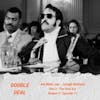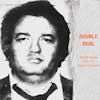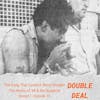
The Founding Fathers - Organized Crime in Early 20th Century Boston

Starting with the days when the Camorra ruled Boston, we introduce the Sicilian men who toppled them: Don Nene Terruso, Don Pepino Modica, Don Filippo Bruccola, and more. And don't miss Lara's personalized food tour of Boston, sharing some of her favorite restaurants and the best food to order there.
Follow us on Twitter for sneak peeks of upcoming episodes. You can also find us on Instagram and Facebook.
Questions or comments, email lara@doubledealpodcast.com or nina@doubledealpodcast.com
Thank you for listening!
All the best,
Lara & Nina
Lara:
Hi everyone! Thank you for listening as always. Today we’re going back in time to early 20th century Boston. Starting with the days of the Camorra also known as the Black Hand, and their activities. From there we will be discussing the men who arrived from Sicily beginning with Nazzareno “Don Nene” Terruso and his brother-in-law Guiseppe “Don Peppino” Modica.
Nina:
And don’t forget my favorite Don of all, Filippo Bruccola!
Lara:
You mean Prince Filippo Bruccola, don’t you?
Nina:
Exactly!
Lara:
From there we will introduce you to the men they gathered around them. We will take you up to the point that Filippo returns to Sicily and Raymond Patriarca takes the driver’s seat. Then next week we’ll be covering Raymond’s early years. So let's talk a little bit about the Black Hand.
Nina:
I’ll be honest with you, I never really knew anything about the Black Hand prior to researching this episode. The Camorra has its roots in Naples and Campania and are still active to this day. The oldest written record is from 1735 in Naples when the organization was granted permission to open eight gambling establishments. Authorities believe there are roughly 200 Camorra groups currently operating outside of Italy.
Lara:
The first time I heard of the Black Hand was in Godfather 2. Don Fanucci with his white hat and coat. He was vile! I always think of the extortion letters they’d send to their victims filled with their shakedown demands. Boston too had quite a few Camorra or Black Hand members. In February of 1908 a woman went to the police saying she received a letter demanding money. That same month a merchant in the North End received a letter written in blood with a picture of a heart pierced with a stiletto knife stating that if he didn’t pay he would be killed.
Nina:
In March of 1909 the Boston Globe ran an article about how Italian businessmen were receiving demand letters. Often there would be half of a business card in an envelope with instructions that a man would appear at their business with the matching half of the business card. The victims were to give the money to the bearer of the card.
Lara:
Others received letters telling them where to leave the protection money such as in a crevice of a wall. The demands were astronomical for those days. One fruit dealer was told to leave $500. Think about that. Instead of giving the money he went straight to the police. This was only a couple of weeks after a priest named Fr. Francis Leberti had been murdered by the Black Hand.
Nina:
Similar cases continued to be reported, handwriting experts were brought in, but it was nearly impossible to arrest, let alone try, anyone. There was even a report of how two Camorra members dressed as priests and one dressed as a woman hopped on a boat to Italy right under the noses of the BPD.
Lara:
Finally in July of 1922 seven Black Hand members were brought to trial for the murder of Michael Scarpone. Scarpone was shot in the North End on January 20th. The trial lasted over a month. One defendant went insane during the trial. The man who bragged of killing Scarpone, Joseph Simboli was aquitted. Upon his release a series of stabbings and shootings plagued the city. Simboli was found shot to death in his car in Orient Heights, East Boston in October of the same year. And the letters continued to come.
Nina:
While the Black Hand was terrorizing Italian immigrants throughout the city another group was moving in. The Sicilians were coming!
Lara:
By 1910 74% of the population in Boston were either immigrants or the children of immigrants. The demographics continued to shift by the time my grandparents arrived. The North, South and West End became known as “the center of emergence.” The native born and German born residents relocated to East Cambridge, Chelsea, Somerville, Watertown, Malden, Quincy and Waltham. Nina, you mentioned to me that you noticed how many of the men we’re discussing today were selling produce and peddlers of one type or another. The second wave of immigrants, my grandpa included, wanted to avoid the factory regime. The successful ones went on to own their own grocery and retail businesses. True entrepreneurs.
Nina:
Something else I didn’t know! Now to our first founding father. Nazzareno “Don Nene” Terruso was born in Monreale, Palermo, Sicily in August 1893. The name seems to be one that was handed down to the oldest son for generations. He arrived alone in New York City in April 1913.
He claimed an exemption from serving in World War One based on his alien status. He was still living in the same neighborhood in New York City, and working as a chauffeur.
Lara:
I wish we could find a better photo of Don Nene. The one from his citizenship application is so faded. He was described as 5 foot 6 inches tall, 150 pounds with brown hair and eyes.
Nina:
Don Nene had a forehead almost as big as yours!
Lara:
I’d describe it as regal, but whatever! When did he move to Boston?
Nina:
By early March 1921, he was living at 347 Hanover Street in Boston. He applied for US citizenship but was denied. He was still unmarried.
In June that same year Don Nene’s sister arrived in Boston with her husband, Giuseppe Modica, and their newborn baby daughter.
Lara:
That brings us to another one of our Founding Fathers, Don Peppino.
Nina:
Giuseppe “Joseph” Modica also known as “Don Pepino” was born in Dec 1896 in Monreale, Palermo, Sicily. He married Don Nene’s sister, Giuseppa, in June 1920.
When he first arrived in Boston he said he was a barber. In the 1930 census he stated that was working in a soda fountain. But by the time of the 1940 census, he’d been naturalized and had his own fish business out on the old T-Wharf.
Lara:
Now you're going to have to teach me something about my own city. What the hell was the T-Wharf?
Nina:
The T-Wharf was located on the north side of the Long Wharf. It was a T shaped dock that was the center of the fish trade in the late 19th and early 20th century. I think they shut it down in the 1960s.
Lara:
I had no idea!
Nina:
Well, we both learned something new today!
While Don Peppino was busy down on the docks, Don Nene got married to a girl with roots in his hometown, Josephine Sansone. He went into business for himself in fruit and tonic manufacturing. He moved his whole family, in-laws included, into a 4,000-square-foot plantation mansion in Lynn that had been built in 1830. There were 11 of them in the house in 1930.
The neighbors must have hated him!
Lara:
Well I don’t know if they hated him, but they certainly weren’t too fond of the dogs he kept on the property. The neighbors were terrified of the German Shepherds. In July of 1928 one of the neighbors finally went to the police. Don Nene had to appear in court. The complaint included that the German Shepherds would chase the kids sledding in the winter, biting the milkman, the grocery boy and the paperboy. Even the officer trying to serve the warrant was attacked by the dogs after which they proceeded to chew the tires off of his motorcycle! Don Nene was fined $15 and ordered to keep the dogs locked up.
Nina:
I know I shouldn’t be laughing, but it must have been a circus.
He was probably running a still out back. His brother in law was caught bootlegging in 1924. The cops in Swampscott seized 16 barrels of wine, 36 quarts of Scotch Whiskey, and 30 gallons of Belgian alcohol! Plus 2000 labels! Joseph Gandolfo was fined $125.
Lara:
Guess that qualifies as a bootlegger! There was another Don Peppino in and out of Boston at that time that there is barely any information on. I was only able to find one news article, but he was also listed in several books and a senate report on narcotics during the 1930s. Giuseppe Failla was known as Joe the American. In 1939 he was arrested in Paris along with 40 others in a narcotics raid. The company he owned was shipping heroin to the US and Mexico.
Nina:
The whole myth that the mob wasn’t involved in narcotics is ridiculous. Look at the men we’ve covered so far in this season. The mafia was clearly involved in drug trafficking not just at a local level but an international level.
Lara:
I agree with you. There is some romanticized fairy tale that there weren’t any drug dealers at least on a sanctioned level in the mob. Maybe the street guys weren’t sanctioned to deal but the bosses obviously weren’t missing out on that market.
Nina:
No question. As For Don Peppino number 2, we really weren’t able to find much more about him.
Lara:
Frustrating! Let’s move onto a much more civilized affair, the Don with his personal chef and chauffeur. The story goes that Filippo Bruccola shipped his own cook and her husband over from Italy to take care of him. This turns out to not be quite true. However, he did manage to hire a woman named Anna and her husband Vincenzo Travaglione. They had arrived from Naples about a decade before he showed up. In 1932 Anna opened up Mother Anna’s on Hanover St. I still remember the delicious manicotti! Once in a while dad would take me there for lunch when I was little. It’s still open. Her grandsons operate it now. One of her other grandsons owns La Scala in Randolph. It’s been operating for 50 years. Good memories of that place too. Sauteed escarole.
Nina:
If I ever get back to Massachusetts, I’ll have to try both of them.
A little bit more about my favorite Don, Prince Filippo Bruccola. Born in Palermo in August 1886, he arrived in New York on the 9th of October 1920. Less than six months later he moved to Boston. By 1924 he was ready to become a citizen of the United States. He never served any time in prison, and only had one conviction which was in 1923 for carrying an unlicensed revolver. He paid a small fine for that offense.
Lara:
I researched Filippo's surname, and it was included in the registry of Noble names. And he certainly had that air about him. Although only of medium stature, he was unquestionably the boss. We were able to find quite a few good photos of Filippo. He could have easily been mistaken for a CEO. Immaculately dressed, always.
Nina:
He was regal!
Lara:
I think he’s your mob crush!
Nina:
I’m ignoring that comment! Richie had Noble lineage too, right?
Lara:
Yes, but his grandma got knocked up by an illegitimate farmhand and lost her ranking. Demoted to peasant status and shipped off to a village far from her disgraced family.
Nina:
You have more than a few of those in your tree, but I don’t think Don Filippo ever lost his status. Let’s come back to the three Dons a little later. Let’s introduce one of your favorites, Big Bozo Cortese.
Lara:
I can’t even tell you how many years I thought Big Bozo was a clown!
Nina:
I can’t, but I understand how a kid of your generation would equate Bozo with a clown.
Lara:
Hey, I was little and the guys older than dad were always going on about Big Bozo this and Big Bozo that. When my aunt Helen would take me to the circus, I kept expecting to see him there, but alas no. So tell us about Big Bozo.
Nina:
Hey, you know there was a Little Bozo too?
Lara:
I didn’t see him at the fucking circus either!
Nina:
Poor Kid! Anthony “Big Bozo” Cortese was born on 1 August 1909 to Angelo and Ellen Murphy Cortese in Boston. His father’s family came from Messina in Sicily. Mom was Irish. His brother Joseph “Little Bozo” Cortese was born in 1913. He was charged with a gangland hit in 1941 and was on the lam for 2 years before being caught and receiving a short sentence. We will get back to Big Bozo shortly.
Lara:
Forgive me, but Big Bozo wasn’t really a looker! At 5 foot 9 and 250 pounds he earned his nickname! If you want to see a pic of him, checkout the episode page on our website. Let’s introduce Frank Cucchiara, Joseph Lombardo, Anthony Sandrelli and Henry Selvitelli.
Nina:
I agree. Frank “Chi Chi” Cucchiara was born on March 29, 1895 in Salemi, Trapani, Sicily. He arrived in New York in May of 1913, then moved to Boston shortly after. Like Big Bozo, he lived on Hanover St. in the North End. He also owned the Purity Cheese Company.
Lara:
The best ricotta! It used to come in this tall tin container with tiny holes in it to keep the cheese dry. It would have a wax paper like cover over the bottom and top with an elastic holding the paper in place.
Nina:
It’s like we are getting a personal food tour of Boston today! You know there is a Cucchiara family in Salemi, Sicily that are still dairy farmers. Must be the same family as Salemi only has a population of around 10,000. But Frank wasn’t just making cheese. He was indicted for obstructing justice after the Appalachin meeting in 1957. Frank was arrested 12 times for a variety of offenses over the years including possession of morphine and dynamite at the same time in 1925, assault, conspiracy, illegal lottery and auto violations.
Lara:
Chi Chi was probably the shortest of the bunch at just a little over 5 feet 3 inches tall. Portly would be a good description.
Nina:
Frank was also a sharp dresser. Don’t forget he once got picked up getting his shoes shined!
Lara:
Now for the tallest on our list, Giuseppe “Joseph” Lombardi or Lombardo depending upon the source was born in Salemi, Trapani, Sicily just like Chi Chi on September 1, 1895. Since it appears he preferred Lombardo, we will stick to that spelling. He arrived in New York on May 18, 1906 along with his brothers Pasquale and Vincent. He claimed exemption from the draft in WW1 because he had to support his parents. At the time he was living in Brooklyn but working in Manhattan. He didn’t settle in Massachusetts until April 1927, but he was making frequent trips to Boston prior to that. Including one in April of 1925 when he and Frank were arrested with dynamite and morphine in a room in Brighton. He claimed he inherited it when his brother passed away. Lombardo had tried to bribe the cops then, but they turned around and added that to the charges against him as well. The court fined him $100 for each offense. Joseph was arrested 16 times in total, but the only jail time he served was 6 months in the house of corrections for carrying a revolver.
Nina:
Arigo “Henry Noyes” Selvitelli was born March 15, 1902 in Boston. I’ll pass on giving a description of Henry! He had a total of 32 arrests but only served 1 year in the House of Correction. He and Big Bozo were arrested for the Livermore Falls Trust bank robbery that occurred on July 27, 1937.
Lara:
Livermore Falls as in Maine?
Nina:
I know, I know, all roads lead to Maine. Their getaway was great! They had brought tacks with them and threw them out the window as the cops were pursuing them, blowing out all the tires of the cruisers.
Henry was described as a former nightclub owner. He was convicted of illegal alcohol sales on November 1, 1940. There was another brother Gennaro “Jerry Noyes” Selvitella who was supposedly a stand-in for Henry when he was out of town.
Now tell us about the Canadian who was also a sharp dresser with his pinky ring.
Lara
Anthony Sandrelli was born in Canada on March 26, 1908. His parents were Sarafina and Carmen Sandrelli. Carmen was also from Trapani. Sarafina and her 5 children left Canada and moved to Boston in April of 1916. Carmen had stabbed another man he was involved in a turf war with. He was acquitted but immediately after that his store was burnt down. Carmen remarried and Sarafina remarried. Anthony’s first arrest was in 1931 for suspicion of murder. He also lived in the North End but on Prince St. And “The Canadian” was his boxing name. Weren’t some of the others also boxers?
Nina:
Yes, “Henry Noyes” was too. A side note, Sandrelli was reportedly Henry Noyes’ chauffeur in later years.
Lara:
And Selvitelli was Big Bozo’s driver at some point.
Nina:
Cortese was arrested in February 1931 after a barroom brawl in Somerville at 2:30 in the morning. With him was Anthony Sandrelli. The two of them were soon cleared, however, and back out causing trouble. They were all connected to each other either in the ring or in the street.
Lara:
For sure, but tell us who was managing our boxers?
Nina:
Both Sandrelli and Sevitelli were being managed by Don Filippo. It’s interesting because Filippo worked closely with Dan Carroll who was a boxing promoter. One of Carroll’s boxers was Steven Gustin. His real surname was Wallace. He took the name Gustin because it was the name of the street where the gym was located that he trained at. He and his brother Frank were members of the Gustin Gang.
Lara:
It seemed that Don Filippo was recruiting soldiers from his stable of boxers.
Nina:
No question. We mentioned earlier that Don Nene and his in-laws were into bootlegging, but they weren't the only ones. Joe Lombardo was called a “rum baron” by the newspapers. Lombardo had an office on Hanover Street, where he was running numbers and selling alcohol. The name of the firm was C. & F. Importers. It was not registered with City Hall. His partners were allegedly Frank Cucchiara and a man named Salvatore Cangemi. Both men were from his hometown of Salemi.
Lara:
In late 1931, the Gustin Gang hijacked $50,000 worth of liquor from Lombardo and hid it at a summer home in Nantasket that supposedly belonged to a Harvard professor. They contacted Lombardo and told him to pay up. Rather than pay, Lombardo tipped off the cops, who seized the liquor.
Nina:
Shortly after that, the Gustin Gang and Lombardo agreed to a sit down. Steve Wallace warned his brother Frankie not to go, but Frankie didn’t listen and went anyway.
According to the authorities, Frankie Wallace and Bernard “Do Do” Walsh, Timothy Coffey and some other gang members drove to the North End at about noon on December 22, 1931. They parked their car on Parmenter Street and headed to Joe Lombardo’s office at 317 Hanover Street.
Lara:
But it didn’t work out the way they thought it would. It was an ambush. Frankie Wallace staggered into the office of attorney Julius Wolfson. He dropped his empty weapon at the doorway, made his way through the room and collapsed into a chair. He leaned over on his left side, his head resting between his legs on the floor. In that “grotesque” position he died. There is a picture on the website. The link is in the show notes.
Nina:
Walsh’s body was found on the second floor landing of the stairwell. The bullet which killed him entered his chest on the upper right side, passed through each lung and the heart. According to the autopsy, “death was necessarily and rapidly fatal”. There was no evidence that the weapon -- a .38 -- was held in close proximity.
Lara:
What happened to Timothy Coffey?
Nina:
Coffey was discovered crouched behind a chair which was behind a screen in the attorney’s office. Coffey had assisted Wallace into the office, and then hidden himself while another member of the Gustin Gang threw Wallace’s empty gun out the closed window onto Hanover Street, where it landed at the feet of a pedestrian. That man then went to the secretary’s desk, and tried calling the cops. He hung up the phone, placed his gun in the desk drawer, and quickly exited the crime scene, disappearing into the chaos.
Lara:
Arrests soon followed.
Cortese and Noyes were both arrested at a shoeshine shop on Hanover Street on December 26th.
The arresting officer later testified that he said to Noyes, “I want you.”
He said, “I expected that.”
The cop said that he then noticed Cortese and said, “I’m going to take you too.”
Cortese was believed to be Noyes’ chauffeur and bodyguard.
Noyes intervened and said, “Give the kid a break, you’ve got me.”
The cop retorted, “Misery likes company.”
He then frisked Cortese, and found three fully loaded pistols on him. One of them was cocked but had the safety on. Noyes was unarmed.
Nina:
Of course Noyes would say that about Cortese! He had three guns on him!
Sandrelli was picked up loitering in the corridors of the Court House on the 28th of December. He must have been waiting around for Noyes and Cortese.
On Thursday, December 31, Joe Lombardo surrendered himself to the police. He entered police headquarters at 4pm accompanied by a bodyguard. The bodyguard was wearing a topcoat that barely reached his knees, and a tattered cap over his eyes. He left Lombardo as soon as he was safely ensconced in the police superintendent’s office. When the superintendent arrived in his office, Lombardo quietly stated, “I don’t want you to think I’m being sassy… but I’m not going to answer any questions.”
In response, the superintendent stood up and opened the door. Lombardo was taken to the third floor, fingerprinted and photographed. His last photograph had been taken by the police in 1925 when he and Frank Cucchiara were arrested for possession of narcotics and dynamite.
Lara:
Lombardo still refused to answer the barrage of rapid-fire questions that came his way for 30 minutes straight from the six officers surrounding him. He kept his word. The police finally gave up and transferred him to a jail cell at Hanover Street police station to await arraignment.
The following evening, Frank Cucchiara and Salvatore Cangemi surrendered themselves too. They were booked, fingerprinted, measured, and photographed. They too requested counsel and refused to talk.
Nina:
A Grand Jury was convened in January 1932. The charges were dismissed against Selvitelli, Big Bozo and Anthony Faucci, no, not that Fauci. Sandrelli had been cleared in December. But Lombardo, Cucchiara and Congemi were still being held.
The judge ruled that the medical examiner did not have the expertise to make a judgement on the forensics, which was still pretty primitive in those days. There were bullet holes in the furniture, walls, and windows. It was unclear who shot what and when.
Lara:
Big Bozo wasn’t free to go though. He had a prior gun charge and disorderly conduct charge that he was granted a suspended sentence on. In April, he was sentenced to 2.5 to 3.5 years in state prison.
Nina:
On March 21, 1932 Lombardo, Cucchiara, and Congemi were freed from Charles St jail as the Grand Jury was unable to return an indictment. No one was ever tried.
Lara:
At the time of the Gustin Gang killings there were 11 gangland slayings that year. It would be another 30 years until the McLean/McLaughlin war would erupt, but over those 3 decades there was no shortage of tension or violence between the competing factions.
Nina:
It was believed that Bruccola was in control of organized crime in Boston and most of New England from 1932 to 1954 when he returned to Sicily. During his time at the top he was more than just a boxing promoter. He was the owner of the Wonderland Race track in Revere, MA and owned race horses.
Filippo was a hero! He sued the IRS for falsely claiming he had undeclared income, and he won the case!
In 1951 he acquired a large interest in an olive oil business in Italy. By 1954 he moved back to Sicily, but returned to Boston, sometimes several times a year into the 1960s. Rumor was he was still pulling the strings even in his so-called retirement.
Lara:
Bruccola was also said to have been a very fair boss. Whenever there was a sit down over someone or their conduct, he always allowed the man to be present regardless of his rank. The man would also be given the chance to present his side of the story.
Nina:
Definitely a good leader. Did you have someone else you wanted to introduce?
Lara:
I want to introduce one more of the old guard, Giovanni “Johnny Williams” Gugliemo. Born February 9, 1913 in Revere, MA he was younger than the rest of the gang, but he continued to run Bruccola’s gambling interests after his return to Sicily. If you listened to last week's episode you might remember that Ralph Lamattina worked under Johnny in his early years. Johnny did not have a lengthy record, but he did have two convictions, both of which resulted in prison sentences. The first was in February of 1934 for passing counterfeit bills. He received an 18 month sentence in Lewisburg. The second was in January of 1941 for assault with intent to rob. He was given a 5 year sentence for that offense. Most of his business interests were in vending machines and jukeboxes.
Nina:
And he also owned the Hotel Capri in Havana. We will be doing a bonus episode about Havana after the first of the year. Johnny’s influence would extend well into the 1960s. In Howie Carr’s book about Johnny Martorano, he says that Johnny’s father sent him to Williams to set him straight. Williams was living at the Bostonian Hotel in the Fenway. He would spend his afternoons in the hotel lounge drinking anisette. The little lecture didn’t work.
Lara:
At least He tried. Anthony Sandrelli continued to be a presence in the Boston mob scene. He worked directly for Joe Lombardo running the numbers racket in the area. Sandrelli was picked up by the police for questioning for almost every murder in the Boston area up until the 1960s. Don Peppino owned a business called the American Finance Company on Hanover St in the North End. He managed to keep himself from being arrested all of those years, but his lending endeavors didn’t always go so well. He lent $5000 to Joseph Rizzo on the OK of Tommy “3 Fingers Brown” Lucchese, but never saw a dime of it.
Nina:
Cucchiara continued to run Purity Cheese, but he also continued in the narcotics trade. He was listed along with other heavyweights Russell Bufalino and Santo Trafficante as controlling the drug flow of narcotics into the US from Europe, Mexico, Cuba, and Canada. Then of course there was the Apalachin meeting in 1957.
Lara:
Well dressed wise guys running through the woods! Maybe we will do a bonus episode on the Apalachin meeting if people are interested.
Nina:
That would be a fun episode!
Lara:
Did you know that Patriarca was brought in for questioning shortly after Apalachin? When SA Homer Wilbur asked him why he wasn’t there, he responded, “why would I be there? That meeting was attended by Sicilians and I’m not Sicilian!”
Nina:
While the old-timers were ruling quietly from behind the scenes, Raymond was dreaming of his own rise to the top. In our next episode we will be discussing Raymond’s rise to power. His sidekick Ben Tilley will be making an appearance again. You might remember Tilley from his brief appearance in episode one with Richie’s mentor, Jack Kelley.
Lara:
Our teaser about Ben Tilley for later in the season is “revenge by robbery.” If you want to know how that plays out then you’ll have to keep listening.
Nina:
And our old school Dons will be popping up again!
Thanks everyone! Please follow us and share with your friends.
Nina & Lara:
BYE!
Featured Episode
Season 2 is finally here!


































